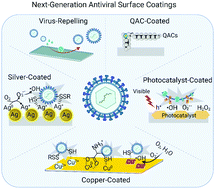Chemical design principles of next-generation antiviral surface coatings
Abstract
The ongoing coronavirus disease 2019 (COVID-19) pandemic has accelerated efforts to develop high-performance antiviral surface coatings while highlighting the need to build a strong mechanistic understanding of the chemical design principles that underpin antiviral surface coatings. Herein, we critically summarize the latest efforts to develop antiviral surface coatings that exhibit virus-inactivating functions through disrupting lipid envelopes or protein capsids. Particular attention is focused on how cutting-edge advances in material science are being applied to engineer antiviral surface coatings with tailored molecular-level properties to inhibit membrane-enveloped and non-enveloped viruses. Key topics covered include surfaces functionalized with organic and inorganic compounds and nanoparticles to inhibit viruses, and self-cleaning surfaces that incorporate photocatalysts and triplet photosensitizers. Application examples to stop COVID-19 are also introduced and demonstrate how the integration of chemical design principles and advanced material fabrication strategies are leading to next-generation surface coatings that can help thwart viral pandemics and other infectious disease threats.



 Please wait while we load your content...
Please wait while we load your content...